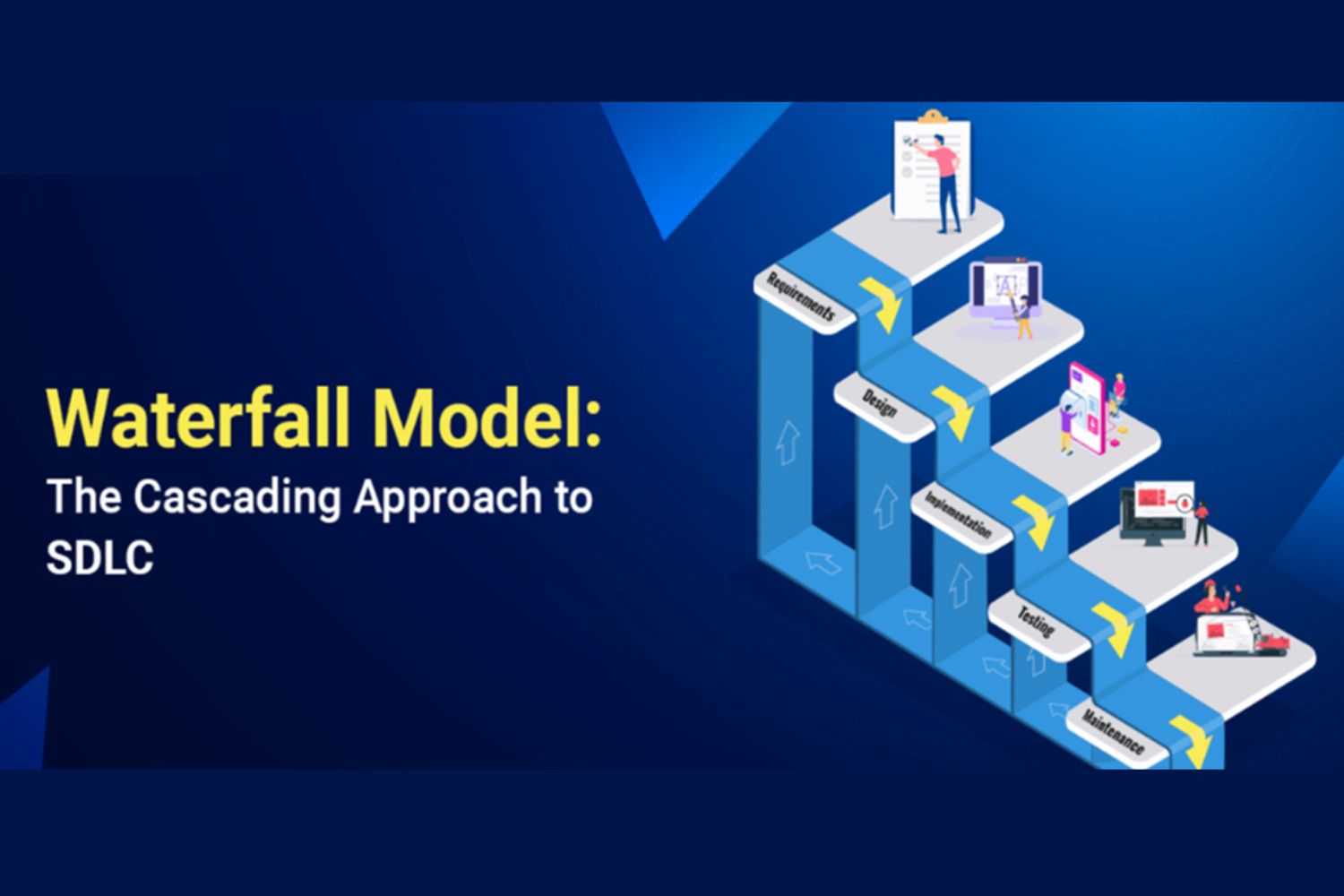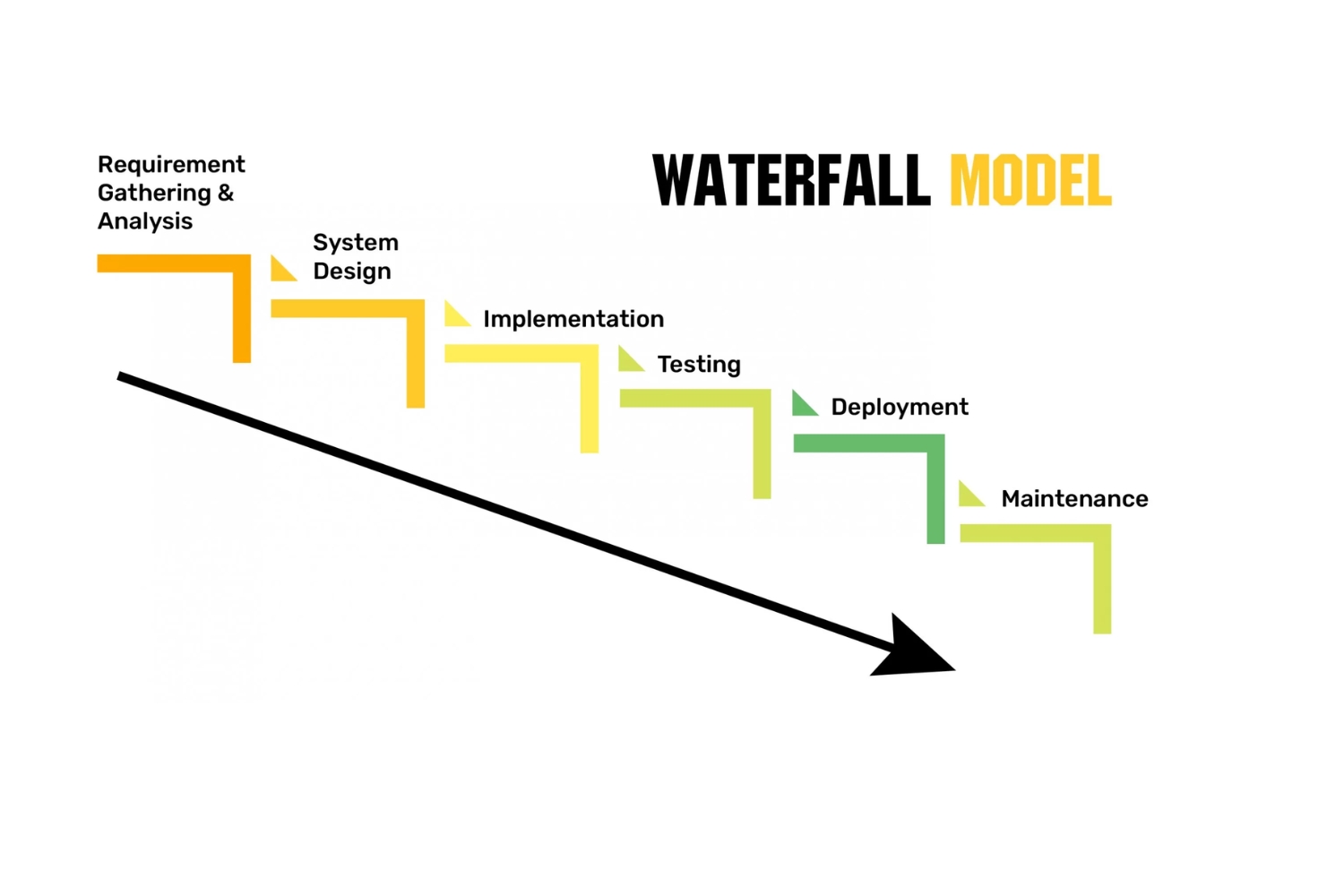
WATERFALL MODEL
The first Process Model to be introduced was the Waterfall Model. It is also known as a life cycle model that is linearly sequential. The fundamental life cycle model for software development is the waterfall model. Though really basic, it is idealistic. It is crucial since the traditional waterfall model serves as the foundation for all other software development life cycle models.

It is quite easy to use and comprehend. There is no phase overlap in a waterfall model; each step must be finished before the next can start .The first software development life cycle (SDLC) approach was the waterfall model . The software development process is depicted in the waterfall model as a sequential, linear flow. This implies that a development process phase can only start after the one before it is finished.
FEATURES OF WATERFALL MODEL
Sequential Approach: The waterfall model uses a sequential approach to software development, meaning that before going on to the next phase, each project phase must be finished.
Document-Driven: To guarantee that the project is precisely defined and that the project team is working toward a defined set of goals, the waterfall model mostly depends on documentation.
Quality Control: To make sure that the finished result satisfies the needs and expectations of the stakeholders, the waterfall approach places a strong emphasis on quality control and testing at every stage of the project.
Strict Planning: The waterfall model calls for a strict planning procedure in which the project’s deliverables, schedule, and scope are all precisely specified and tracked over the course of the project’s lifecycle.
In general, the waterfall paradigm is applied to software development when a highly organized and methodical approach is required. It can be useful in making sure that big, complicated projects are finished with excellent quality, on schedule, and within budget.

PHASES OF WATERFALL MODEL
This method of developing software is sequential and linear, with multiple stages that need to be finished in a particular order. The stages consist of :
Study of Feasibility: This phase’s primary objective is to ascertain whether developing the program would be technically and financially possible. Understanding the issue and identifying potential solutions are the first steps in the feasibility study. After weighing the advantages and disadvantages of each of the several solutions found, the best option is selected, and the next stages are completed in accordance with the solution plan.
Analysis and Specification of Requirements :Understanding the customer’s precise requirements and accurately documenting them is the goal of the requirement analysis and specification phase.
Requirement collection and analysis: All software needs are first obtained from the client, and then the requirements are examined. Eliminating inconsistencies and incompleteness is the aim of the analysis section. An incomplete requirement is one that leaves out some of the actual requirements, while an inconsistent requirement is one that has contradictory components.
Develop : This phase’s objective is to transform the requirements found in the SRS into a format that can be programmed using a computer language. It encompasses the overall software architecture in addition to high-level and detailed design. All of this work is documented using a software design document (SDD).
Unit testing and coding :Using any appropriate programming language, software design is converted into source code during the coding step. Each designed module is therefore coded. Unit testing is the process of determining whether or not each module is operating as intended.
System and integration testing : Every stage of integration involves testing the completed system once previously designed modules are added to the partially integrated system. Ultimately, the entire functional system is obtained and subjected to system testing following the successful integration and testing of all the components.
Maintenance: The most crucial stage of a software life cycle is maintenance. The entire effort required to produce a complete piece of software is divided into 60% maintenance effort..
BENEFITS OF CLASSICAL WATERFALL MODEL
A Classical approach to software development is the waterfall model. Because of its simplicity, it can serve as the foundation for additional software development life cycle models. Some of the main benefits of this SDLC methodology are listed below.
Simple and Easy to Understand: The Classical Waterfall Model is quite straightforward.
Individual Processing: In the Classical Waterfall paradigm, each phase is handled independently.
Appropriately Defined: Every step in the traditional waterfall model has a precise definition.
Explicit Milestones: The Classical Waterfall model contains extremely explicit and well-defined milestones.
Appropriately Recorded: Procedures, actions, and outcomes have excellent documentation.
Promotes Good Habits: The define-before-design and design-before-code methodologies are promoted by the classic waterfall model.
Functioning: Smaller projects and projects with well defined requirements are a good fit for the classical waterfall model.
USE CASE OF WATERFALL MODEL
Large-scale Software Development Projects: When a systematic and sequential strategy is required to guarantee that the project is finished on schedule and within budget, the Waterfall Model is frequently utilized.
Safety-Critical Systems: The Waterfall Model is frequently applied in the development of systems where errors or flaws could have serious repercussions, such aerospace or medical systems.
Government & Defense Projects: Where a strict and organized methodology is required to guarantee that the project satisfies all requirements and is delivered on schedule, the Waterfall Model is also frequently employed in these types of projects.
Projects having clear needs: Due to the sequential structure of the approach, the Waterfall approach works best for projects with clearly stated needs.
Projects with well-defined requirements: Because the Waterfall Model is sequential in nature and necessitates a clear comprehension of the project objectives and scope, it is most appropriate for projects with well-defined requirements.
Projects with Stable Requirements: Because the Waterfall Model is linear and does not permit changes once a phase is finished, it is also a good fit for projects with stable requirements.
JOB ROLES
Waterfall model is applied to large-scale, intricate projects, usually in the information technology industry. It is distinguished by a methodical, systematic approach to software development and project management.
Here are a few job roles in waterfall model
1.THE DEVELOPER.
2.THE WATERFALL TESTER.
3.BUSSINESS ANALYST
4.PROJECT MANAGER
SALARY
The Salary of waterfall Testing Range from 13LPA to 35LPA
COURSE HIGHLIGHTS
1. Suited for Students, freshers, professionals and corporate employees.
2. Live Online Classes.
3. 4 month program.
4. Certificate of Completion.
5. Decision Of Oriented Program Of Analysis.
6. Live Classes by Highly Experienced Faculties.
7. Hans-on experiences with real-life cases Studies.

CONCLUSION:
To Conclude , the waterfall model of software development is a tried-and-true, linear methodology that has worked well for a lot of projects. It entails segmenting the development process into discrete steps, each of which has well defined goals, requirements, and deliverables. This can facilitate project management and guarantee that it moves forward in a methodical and organized way . The waterfall model, however, has the potential to be rigid as well, making it unsuitable for projects whose requirements are expected to alter over time.

